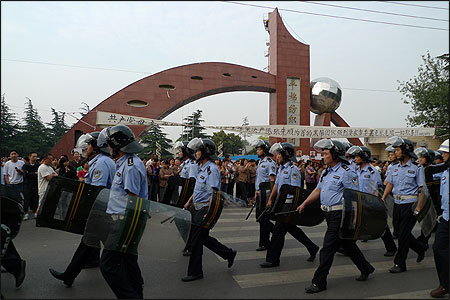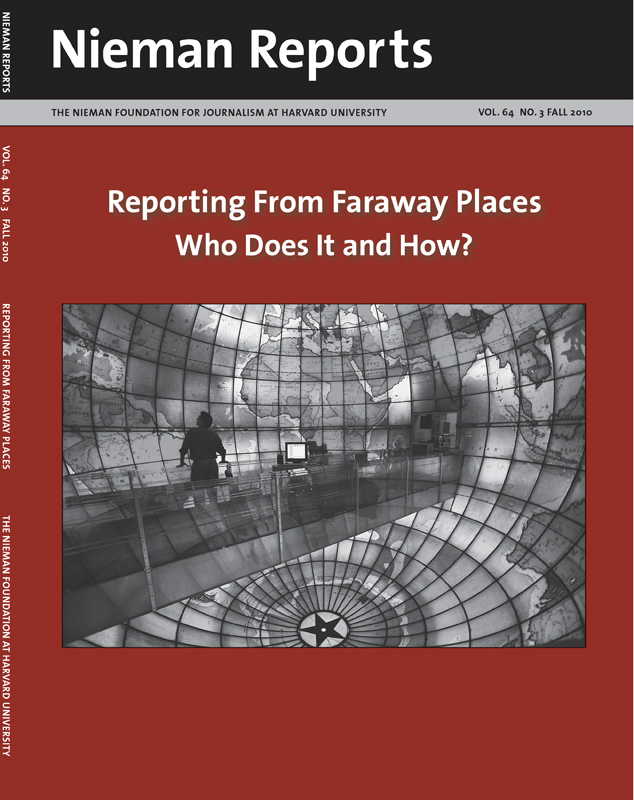
Uniformed police march in the central Chinese city of Pingdingshan during a workers’ strike that local journalists were barred from covering but became front-page news in The Toronto Star. Photo by A. Zhang.
“There’s a textile workers’ strike in Henan province.”
It’s Monday morning in Beijing, shortly before noon, and my Chinese assistant has just spotted a reference to a strike in the Chinese heartland posted on the Web site of a Hong Kong nongovernmental organization.
“How many workers?” I ask.
“More than 5,000.”
“Who’s reporting on it?”
“No one that I can see.”
Two hours later we’re boarding a train at Beijing West Railway Station. I estimate we’ll be in Henan’s capital Zhengzhou by sundown, grab an early morning bus to Pingdingshan—the site of the strike, about 1,000 kilometers south of Beijing—and be in the thick of it by midmorning.
This is, after all, why my newspaper, The Toronto Star, pays for me to be here: To try as much as possible to go deep into the culture and the countryside, to try to bring back an understanding of a complex country that is changing, virtually, at warp speed. I cannot do that from my desk in Beijing, equipped as it is with all the wondrous tools of the digital age. Nor can I tell this story in bursts of 140 characters. And I can’t rely on Google—since Google, as we all know, isn’t at such places.
It’s really up to us. And it’s reporting—notebook in hand, on the ground, verifiable reporting—that remains at the core of our craft, especially for foreign reporting, where coming to grips with a different culture is never an easy task.
In our anxiety-stricken, content-driven age, when the predominant goal seems to be to upload content to the Web site as soon as possible, I’m fortunate to work for a paper that still believes in foreign reporting, still pays for it, and still understands that it takes time and a measure of money—spent prudently—to go deep. If we ever hope to explain what Lyndon Johnson’s late presidential adviser Jack Valenti once called a foreign culture’s “ancestral rhythms,” we have to go to where those rhythms play out—and watch as they are rearranged on a daily basis.
We’ve got to get close enough to listen—and understand what we are hearing.
At a time when many American newspapers are closing foreign bureaus, relying on wires or on reporters surfing the Web and working social networks, there isn’t a day that goes by that I don’t consider myself lucky to work for a paper that still gets it. Sure, it’s possible to parachute into a breaking news event and pull down content and contacts by making efficient use of the Net. But on a broad-based, developing story like China—which continues to change our world in profound ways daily—you have to commit: You’ve got to be here for the long haul. Make no mistake: The Star has closed bureaus, too, paring back to a precious few, to what might be called “the once and future powers”—Washington, Beijing and New Delhi. In those bureaus, correspondents are keenly aware of their need to stay focused on story and deliver content that not only amuses, when appropriate, but also always matters.
They also need to make ample use of fast new technologies, but not become obsessed by them. These are, after all, tools meant to help us tell stories in ever more captivating ways. But the stories we report are why we’re here and, in the end, it’s why readers will turn to us for news and information.
Shoe-Leather Reporting
In the spring of 2006, Tom Friedman wrote a tribute to his early mentor in United Press International’s London office, the late Leon Daniel. I read it during my Nieman year and it still resonates with me—even more so as we speed forward through our digital age. Daniel had taught him the fundamental fact of all good journalism, memorable advice that stuck with him, just as it does now with me: “If it isn’t based on shoe-leather reporting, it isn’t worth a bucket of beans.”
Today I fear we risk producing a generation of journalists who are coming to consider on-the-ground reporting as a quaint endeavor from another era—the snail mail equivalent of newsgathering: slow, time-consuming and with delayed delivery. After all, with the retrieval of information and opinion from social networking sites making it possible to provide near-instant content ready for upload to the Web, why bother to board a plane, train or even take a taxi across town?
Editors and journalism educators I speak to share my worry. Some speak of a generation of nascent journalists who are supremely tech-savvy—but a segment of whom are becoming less interested in leaving the newsroom, and equally wary of picking up a telephone. “I really believe a good number are actually afraid to interview people,” one professor told me recently.
Most good journalists I know would still travel 1,000 kilometers at a moment’s notice for a good lede, as would I. So off my assistant and I went that day.
In Pingdingshan, we landed on a breathtaking scene: 1,000 police officers—with guns, batons, helmets and riot shields—3,000 striking workers, and an armada of police vehicles that had sealed off the road where the factory was located.
Our arrival sparked a sensation: Police swept in on us demanding papers. The crowd swept in on them to make sure we stayed. With papers in hand and the people behind us—a few shoving the police—the police finally backed off. Then, something extraordinary happened: The people applauded us.
The textile workers’ strike was into its 19th day, and it appeared that we were the first journalists to arrive. We learned later that a brave young Chinese journalist from Hong Kong was also working her way through the crowd. Journalists from a newspaper with offices located on the same street as the strike were banned by the government from reporting on the strike.
Yes, here in a nation of 1.3 billion people in 2010, Pingdingshan was a great story—but one contained to within a few city blocks, with news of it passed on mainly by word of mouth. No wonder people were pleased we’d come. Two local bloggers had done their best to get the news out. But in a country with more than 50 million blogs, Pingdingshan’s plight was lost in cyberspace, a plaintive note in the hum of informational muzak swirling about China every day.
That evening, over tea in a private apartment, four workers with 100 years of experience among them told us stories of hellish working conditions: a punishing cycle of two-day rotating shifts, harsh and arbitrary fines, and workers fainting in 105-degree heat. Many earned about 65 cents per hour.
This story went on our front page, and then The New York Times graciously cited it in an editorial on July 5th.
The strike was ultimately suppressed, the workers forced back to their workstations, and we returned to Beijing.
But only, I assure you, for a little while.
Bill Schiller, a 2006 Nieman Fellow, is based in Beijing as the Asia bureau chief for The Toronto Star.



